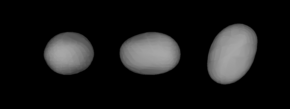283 Emma
 A three-dimensional model of 283 Emma based on its light curve | |
| Discovery | |
|---|---|
| Discovered by | Auguste Charlois |
| Discovery date | 8 February 1889 |
| Designations | |
| (283) Emma | |
| Pronunciation | /ˈɛmə/[1] |
| A889 CA, 1980 FJ12 | |
| Main belt (Emma) | |
| Orbital characteristics[2] | |
| Epoch 31 July 2016 (JD 2457600.5) | |
| Uncertainty parameter 0 | |
| Observation arc | 122.26 yr (44655 d) |
| Aphelion | 3.49701 AU (523.145 Gm) |
| Perihelion | 2.59675 AU (388.468 Gm) |
| 3.04688 AU (455.807 Gm) | |
| Eccentricity | 0.14773 |
| 5.32 yr (1942.6 d) | |
Average orbital speed | 17.07 km/s |
| 127.107° | |
| 0° 11m 7.148s / day | |
| Inclination | 7.99162° |
| 304.369° | |
| 53.7020° | |
| Known satellites | 1 (9±5 km)[3] |
| Physical characteristics | |
| Dimensions | 148.06±4.6 km (IRAS)[2] 160±10 km (AO)[3] |
| Mass | 1.38×1018 kg[4] |
Mean density | 0.81±0.08 g/cm3[4] |
| 6.896 h (0.2873 d)[2] | |
| 0.0262±0.002[2] (Dark) | |
| 8.72[2] | |
283 Emma is a large asteroid of the asteroid belt and the namesake of the Emma family. It was discovered by Auguste Charlois on 8 February 1889, in Nice, France. The reason for its name is unknown.[5]
Measurements made with the IRAS observatory give a diameter of 145.70 ± 5.89 km and a geometric albedo of 0.03 ± 0.01. By comparison, the MIPS photometer on the Spitzer Space Telescope gives a diameter of 145.44 ± 7.72 km and a geometric albedo of 0.03 ± 0.01. When the asteroid was observed occulting a star, the results showed a diameter of 148.00 ± 16.26 km.[6]
Satellite
[edit]A companion for 283 Emma was detected on 14 July 2003 by W. J. Merline et al. using the Keck II telescope and is designated S/2003 (283) 1. The announcement is contained in the International Astronomical Union Circular (IAUC) 8165.[7] The satellite orbits at a semi-major axis of about 581 km with an eccentricity of 0.12.[3] Emma has a Hill sphere with a radius of about 28,000 km.[3]
References
[edit]- ^ "Emma". Dictionary.com Unabridged (Online). n.d.
- ^ a b c d e "JPL Small-Body Database Browser: 283 Emma". Solar System Dynamics (2008-10-30 last obs). Retrieved 11 May 2016.
- ^ a b c d Marchis, Franck; P. Descamps; J. Berthier; D. hestroffer; F. vachier; M. Baek; A. Harris; D. Nesvorny (2008). "Main Belt Binary Asteroidal Systems With Eccentric Mutual Orbits". Icarus. 195 (1): 295–316. arXiv:0804.1385. Bibcode:2008Icar..195..295M. doi:10.1016/j.icarus.2007.12.010. S2CID 119244052.
- ^ a b Jim Baer (12 December 2010). "Recent Asteroid Mass Determinations". Personal Website. Archived from the original on 29 January 2009. Retrieved 17 July 2015.
- ^ Lutz D. Schmadel (2003). Dictionary of Minor Planet Names (5th ed.). Springer Science & Business Media. p. 40. ISBN 978-3-540-00238-3.
- ^ Ryan, Erin Lee; et al. (April 2012), "The Kilometer-Sized Main Belt Asteroid Population as Revealed by Spitzer", arXiv:1204.1116 [astro-ph.EP]
- ^ S/2003 (283) 1 (Circular No. 8165)
External links
[edit]- Asteroids with Satellites, Robert Johnston, johnstonsarchive.net
- Orbits of Binary Asteroids with Adaptive Optics (VLT images)
- 283 Emma at AstDyS-2, Asteroids—Dynamic Site
- 283 Emma at the JPL Small-Body Database
